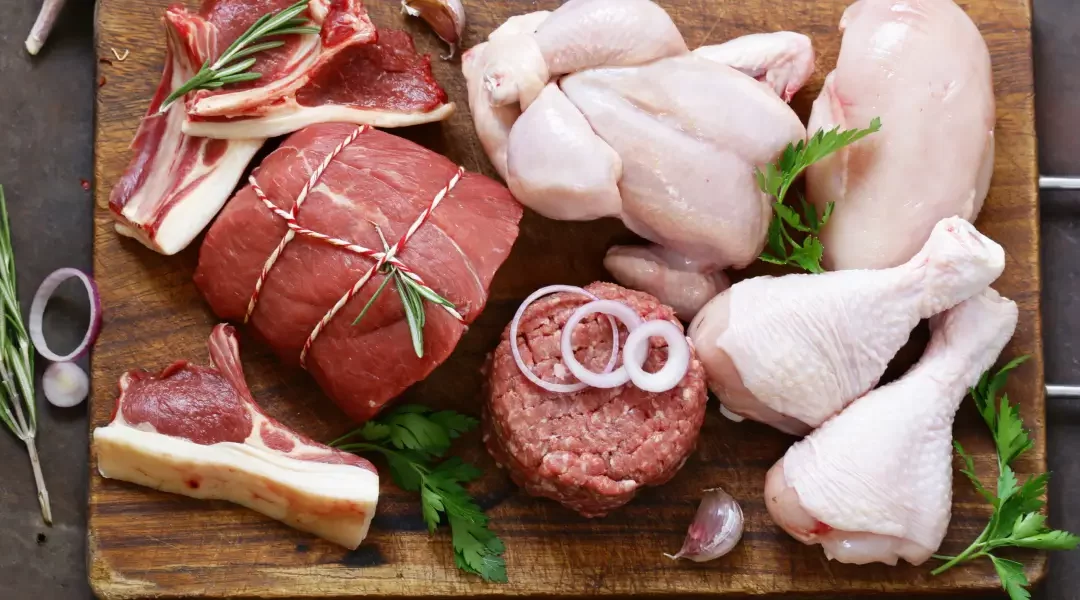Animals must be slaughtered a certain way in order to be considered halal. When not slaughtered with this technique, the meat of the animals is considered forbidden, or haram.
General Halal Certification Requirements for Meat & Poultry
| # | Requirement Area | Key AHF Expectations |
| 1 | Scope & Eligible Species | Only halal-permitted livestock and birds (e.g., cattle, sheep, goats, deer, chicken, turkey, duck, quail). Swine, carnivores, birds of prey, pests, mules, donkeys, amphibious species, blood, etc., are categorically haram. |
| 2 | Animal Welfare & Sourcing | Animals must arrive alive, healthy, and handled humanely—no slaughter in view of other animals, no abuse. Moreover, animal feed must be halal-compliant (no porcine by-products, etc.). |
| 3 | Stunning Policy | Only reversible stunning permitted; animals must be alive & capable of recovery at cut. Stunning equipment tested, calibrated, and logged; non-reversible or lethal methods are prohibited. |
| 4 | Slaughter (Dhabiha) Method | 1. Sharp knife—single swift cut without lifting blade.2. Cut severs trachea, esophagus, both jugulars & carotids without severing spinal cord.3. Complete exsanguination; no dressing until death is certain. |
| 5 | Post-Slaughter Handling | • Heads/skins removed only after death.• Halal carcasses are chilled, processed, and stored strictly apart from non-halal product lines. |
| 6 | Segregation & Cross-Contamination Control | • Physical or validated temporal separation from non-halal raw materials, tools, belts, storage, and transport.• Dedicated or fully sanitised equipment; colour-coded utensils preferred.• Written cleaning validation demonstrating removal of najis residues. |
| 7 | Documentation & Traceability | • Batch-wise records: lot/plant numbers, slaughter dates, stunning logs, ingredient COAs, and cleaning records.• Change-control: any alteration in process, sanitation chemicals, and suppliers must be documented. |
| 8 | Sampling, Testing & Laboratories | • Testing only in ISO 17025-accredited halal labs; porcine DNA screening where risk identified.• All lab reports must be retained for audit. |
| 9 | Surveillance & Audit Frequency | • Annual on-site audit by the halal certification body; interim spot checks possible.• Continuous internal monitoring by the plant’s Halal Committee.• Non-conformities require documented corrective action and verification before certification is re-confirmed. |
| 10 | Imported/Exported Meat Documents | • Each consignment must carry an approved halal certificate, health certificate, and shipping docs that match physical labels (lot, plant, date). |
| 14 | Reference Standards | AHF halal standards aligns with GSO 993 & 713, SMIIC 1, MS 1500, SNI 99002/99003, ISO 17065 and local competent-authority rules (USDA-FSIS, ESMA, BPJPH, etc.). |
Why Slaughter Halal?
The purpose of the Islamic instruction to slaughter halal is to perform the process quickly and with minimal suffering. If you are performing the slaughter, Islam clearly instructs you to slaughter swiftly and with mercy for the animal.
The requirement of draining blood from the carcass allows for the removal of toxins, harmful bacteria, and germs. This has led to many non-muslim halal consumers to believe the taste of the meat to be more wholesome and tender.
Halal Slaughter and Animal Welfare
Animal welfare is another important part of Islam that has been around since long before the movements of animal rights activists. Farmers in Islam have held close the instruction to treat animals humanely and to feed them diets that are proper. Abuse of animals is strictly forbidden and the lives of animals are only to be taken in a dignified manner.
Before the halal slaughter of a bird or animal there are certain aspects to keep in mind:
- Practice mercy from the start to the finish
- Do not slaughter one animal in front of other animals
- Sharpen the knife to prevent the animal from suffering from prolonged pain
Origins of Halal
In the Quran, Muslims have been commanded by Allah to eat only food that is wholesome, pure, and permissible, fit to be eaten by humans. Many mentions are made in the Quran to direct the faithful in how to eat properly. The holy book directs the basic requirements of the ritual means of slaughtering, known as Zibah. It forbids carrion, animals that are suffering ailments, and animals killed by strangling or a headlong fall. As pork is forbidden meat, halal slaughtering has also been instructed to avoid areas of porcine slaughter.
Many restaurants and stores are including halal meats in their selections to better cater to the fast-growing Muslim portion of the population. Halal slaughtering is praised for its devotion to reducing pain and suffering in the animals being slaughtered as much as possible. The swift cut with the keenest of blades to the jugular, carotid, and windpipe makes halal a merciful and fast ending for an animal that has been treated well in life.
If your Meat & Poultry business is interested in halal certification, contact the American Halal Foundation today at +1 (630) 759-4981 for more information on our efficient three-step process.
Frequently Asked Questions (FAQs)
1.How long does AHF halal certification for meat & poultry take?
With complete documentation and audit readiness, most plants finish in 4–8 weeks from application to certificate issuance. Complex multi-site operations may add 2–4 weeks for scheduling.
2.What does the certification process cost?
Pricing depends on plant size, risk, and export document volume. Obtain a quote here.
3.Will my AHF certificate be accepted overseas?
AHF is recognized internationally and will ensure your product meets import halal requirements across major Muslim markets.
4.How soon can I use the AHF halal logo?
After you pass the audit and sign the licensing agreement, AHF provides vector artwork and brand-usage rules. Pre-print proofs must be approved before production labels go live.
5.Can AHF combine halal with SQF or GMP audits?
Yes, AHF has acquired the ability to carry integrated audits, merging halal with SQF, FSSC 22000, or GMP checks, cutting duplicate site visits and saving up to 30% on annual compliance costs.
6.How do we maintain certification year-to-year?
Maintain daily halal checks, log stunning data, and keep ingredient COAs current. AHF performs an annual surveillance audit; clear corrective-action evidence keeps your certificate uninterrupted.
Mohammad Mazhar Hussaini is a pioneering figure in the global halal movement and the President of the American Halal Foundation (AHF), an internationally-recognized halal certifying body based in the USA. With a career spanning over four decades, Hussaini has been instrumental in shaping halal certification standards and practices worldwide.
In 1983, Mazhar Hussaini conducted one of the first formal halal audits in the United States, laying the groundwork for structured halal certification processes. His efforts have been pivotal in ensuring that halal standards are maintained across various industries, including food production and pharmaceuticals.
As an author, Mazhar Hussaini has contributed extensively to Islamic literature, focusing on dietary laws and ethical practices. His notable works include “Islamic Dietary Concepts & Practices“, “The Institution of Fasting”, and “My Little Book of Halal and Haram”, among others . These publications serve as essential resources for understanding halal principles and their application in daily life.
Under his leadership, the American Halal Foundation continues to uphold rigorous halal standards, providing certification services that are recognized globally. Hussaini’s unwavering commitment to halal integrity has significantly influenced the industry’s growth and consumer trust in halal-certified products.




